Project Plan for Red Rooster's ERP System Implementation (MIS)
VerifiedAdded on 2020/05/28
|25
|5256
|78
Report
AI Summary
This report presents a project plan for implementing an Enterprise Resource Planning (ERP) system at Red Rooster, a fast-food chain. The report begins with a letter to a potential sponsor and includes an executive summary. It then outlines the project's objectives, identifies problems with the existing information system, and proposes an ERP solution to enhance business continuity and explore new opportunities. The report details the System Development Life Cycle (SDLC) steps, analyzes the existing business system, provides a project schedule with a Gantt chart, and proposes a budget. It also includes stakeholder analysis, a risk identification and management plan, and a change management plan. The report concludes with a discussion of the benefits of the proposed ERP system and references supporting literature.

Running Head: MANAGING INFORMATION SYSTEMS
Letter to Sponsor
Dear David Duff,
I am <INSERT NAME>, Business and Marketing Manager for Red Rooster. You should
know that as a part of our business plan and strategy, we are looking to implement ERP system
that will not only enhance our business but will also provide us with some new business
opportunities as we continue to grow. It is in my knowledge that you make significant
investments in projects where you can also earn high values of profit. Hence, as we are looking
for sponsor who will invest in our project and support us with sufficient funds, we have selected
you as one of the potential investors in the project. To clear your doubts regarding investment, I
have attached overall proposed budget for the project and the possible cost benefit from which
you will also receive a major share. I have also attached the project plan document so that you
are better prepared to learn about the project and its future prospects. We at Red Rooster hope to
build up a partnership in a short time that will benefit both the parties sufficiently.
Sincerely,
<INSERT NAME>
Business and Marketing Manager
Red Rooster
Letter to Sponsor
Dear David Duff,
I am <INSERT NAME>, Business and Marketing Manager for Red Rooster. You should
know that as a part of our business plan and strategy, we are looking to implement ERP system
that will not only enhance our business but will also provide us with some new business
opportunities as we continue to grow. It is in my knowledge that you make significant
investments in projects where you can also earn high values of profit. Hence, as we are looking
for sponsor who will invest in our project and support us with sufficient funds, we have selected
you as one of the potential investors in the project. To clear your doubts regarding investment, I
have attached overall proposed budget for the project and the possible cost benefit from which
you will also receive a major share. I have also attached the project plan document so that you
are better prepared to learn about the project and its future prospects. We at Red Rooster hope to
build up a partnership in a short time that will benefit both the parties sufficiently.
Sincerely,
<INSERT NAME>
Business and Marketing Manager
Red Rooster
Paraphrase This Document
Need a fresh take? Get an instant paraphrase of this document with our AI Paraphraser
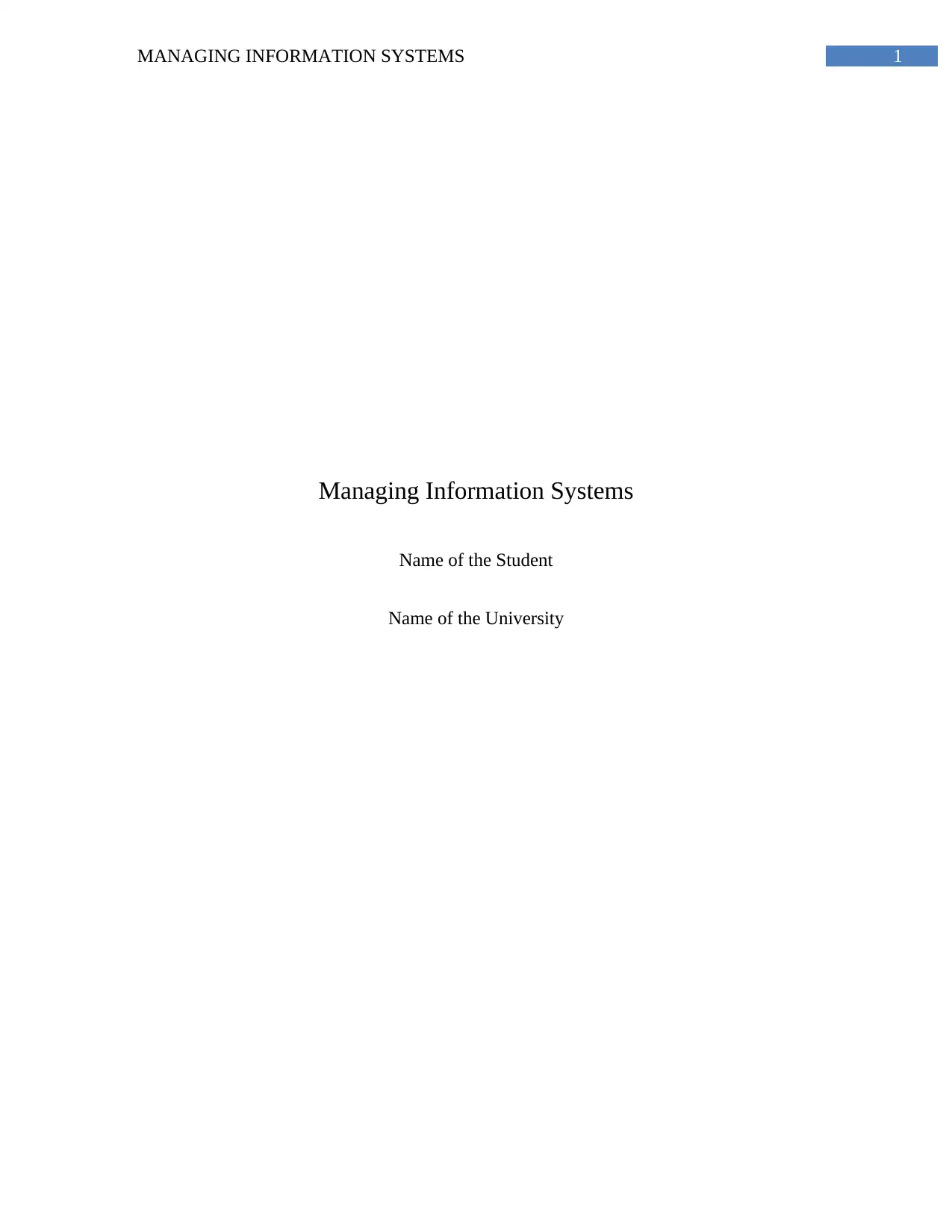
1MANAGING INFORMATION SYSTEMS
Managing Information Systems
Name of the Student
Name of the University
Managing Information Systems
Name of the Student
Name of the University

2MANAGING INFORMATION SYSTEMS
Table of Contents
Letter to Sponsor..............................................................................................................................0
Executive Summary.........................................................................................................................3
1.0 Introduction................................................................................................................................4
2.0 Project Development and Implementation Plan........................................................................4
2.1 Project Objectives..................................................................................................................4
2.2 Identification of Problem and Proposed Solution..................................................................5
2.3 Discussion of SDLC Steps.....................................................................................................6
2.4 Analysis of Existing Business System.................................................................................10
2.5 Project Schedule and Gantt Chart........................................................................................11
2.6 Proposed Budget and Expenses...........................................................................................15
2.7 Stakeholder Analysis...........................................................................................................19
2.9 Risk Identification and Management Plan...........................................................................20
2.10 Change Management Plan.................................................................................................21
3.0 Conclusion...............................................................................................................................22
References......................................................................................................................................23
Appendix........................................................................................................................................27
Table of Contents
Letter to Sponsor..............................................................................................................................0
Executive Summary.........................................................................................................................3
1.0 Introduction................................................................................................................................4
2.0 Project Development and Implementation Plan........................................................................4
2.1 Project Objectives..................................................................................................................4
2.2 Identification of Problem and Proposed Solution..................................................................5
2.3 Discussion of SDLC Steps.....................................................................................................6
2.4 Analysis of Existing Business System.................................................................................10
2.5 Project Schedule and Gantt Chart........................................................................................11
2.6 Proposed Budget and Expenses...........................................................................................15
2.7 Stakeholder Analysis...........................................................................................................19
2.9 Risk Identification and Management Plan...........................................................................20
2.10 Change Management Plan.................................................................................................21
3.0 Conclusion...............................................................................................................................22
References......................................................................................................................................23
Appendix........................................................................................................................................27
⊘ This is a preview!⊘
Do you want full access?
Subscribe today to unlock all pages.

Trusted by 1+ million students worldwide
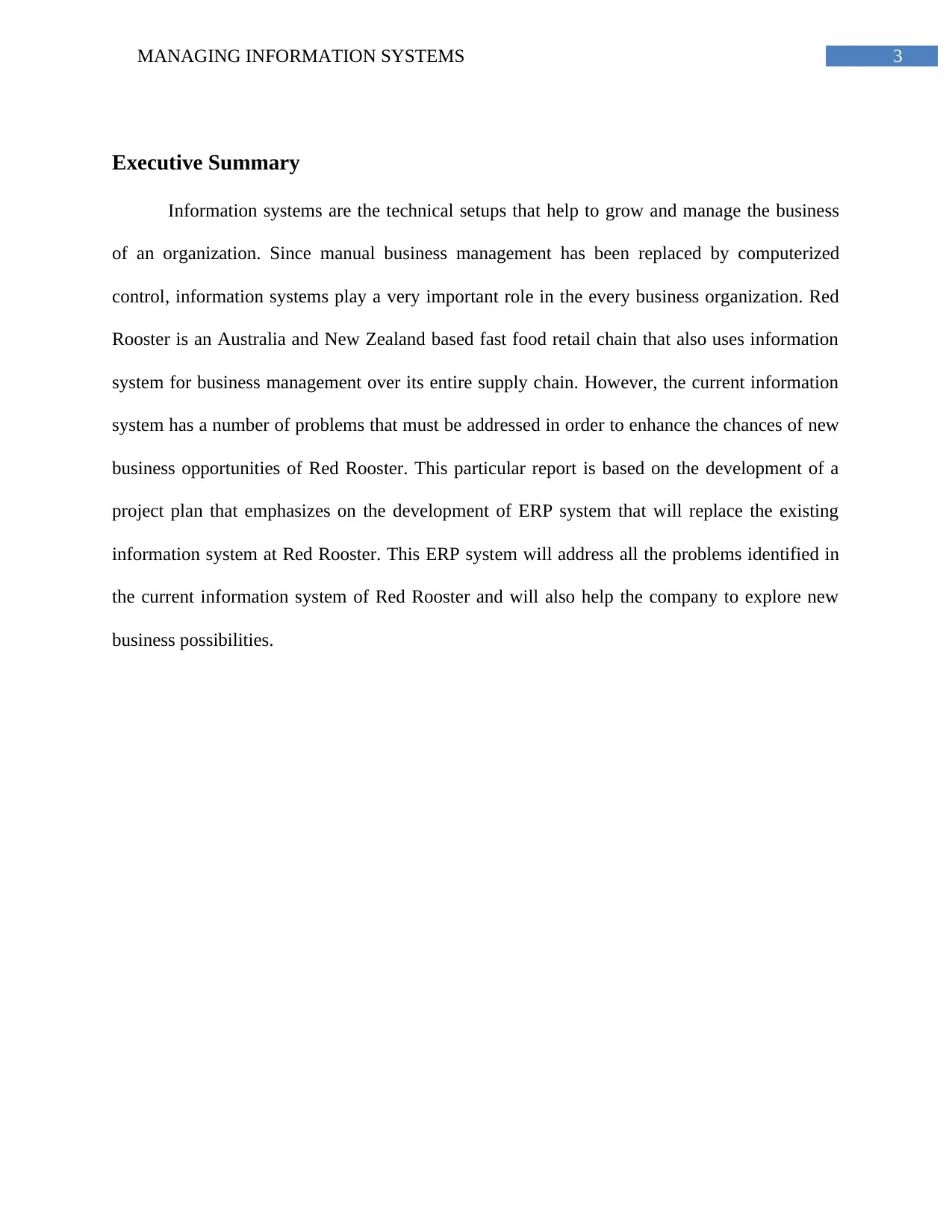
3MANAGING INFORMATION SYSTEMS
Executive Summary
Information systems are the technical setups that help to grow and manage the business
of an organization. Since manual business management has been replaced by computerized
control, information systems play a very important role in the every business organization. Red
Rooster is an Australia and New Zealand based fast food retail chain that also uses information
system for business management over its entire supply chain. However, the current information
system has a number of problems that must be addressed in order to enhance the chances of new
business opportunities of Red Rooster. This particular report is based on the development of a
project plan that emphasizes on the development of ERP system that will replace the existing
information system at Red Rooster. This ERP system will address all the problems identified in
the current information system of Red Rooster and will also help the company to explore new
business possibilities.
Executive Summary
Information systems are the technical setups that help to grow and manage the business
of an organization. Since manual business management has been replaced by computerized
control, information systems play a very important role in the every business organization. Red
Rooster is an Australia and New Zealand based fast food retail chain that also uses information
system for business management over its entire supply chain. However, the current information
system has a number of problems that must be addressed in order to enhance the chances of new
business opportunities of Red Rooster. This particular report is based on the development of a
project plan that emphasizes on the development of ERP system that will replace the existing
information system at Red Rooster. This ERP system will address all the problems identified in
the current information system of Red Rooster and will also help the company to explore new
business possibilities.
Paraphrase This Document
Need a fresh take? Get an instant paraphrase of this document with our AI Paraphraser

4MANAGING INFORMATION SYSTEMS
1.0 Introduction
Red Rooster is a fast food retail chain that mainly conducts business over various parts of
New Zealand and Australia. Recently it has been found that the current information system used
by the company is not sufficient in terms of the current market and there are a lot of issues
occurring due to this (Gupta and Naqvi 2014). The company wishes to address and solve these
issues immediately as well as venture new business possibilities that will enhance the growth of
the company including entrance in new and international markets.
In this report, a project plan has been provided that deals with the planning of the entire
system development life cycle of the proposed ERP system that will solve the problems
highlighted in the current information system at Red Rooster. The new ERP system will replace
the existing information system and will increase the business efficiency in fulfilling business
goals and opportunities set by the company.
2.0 Project Development and Implementation Plan
2.1 Project Objectives
The main objective of this project is to identify an information system related problem
faced by the chosen organization and propose a system that will be able to solve the identified
problem as well as allow new business possibilities for the organization.
In this particular project, the chosen organization is Red Rooster Australia, which is a fast
food restaurant chain dealing with chicken based food products. From the analysis of the existing
business information system used by Red Rooster, it has been found that the main problem faced
1.0 Introduction
Red Rooster is a fast food retail chain that mainly conducts business over various parts of
New Zealand and Australia. Recently it has been found that the current information system used
by the company is not sufficient in terms of the current market and there are a lot of issues
occurring due to this (Gupta and Naqvi 2014). The company wishes to address and solve these
issues immediately as well as venture new business possibilities that will enhance the growth of
the company including entrance in new and international markets.
In this report, a project plan has been provided that deals with the planning of the entire
system development life cycle of the proposed ERP system that will solve the problems
highlighted in the current information system at Red Rooster. The new ERP system will replace
the existing information system and will increase the business efficiency in fulfilling business
goals and opportunities set by the company.
2.0 Project Development and Implementation Plan
2.1 Project Objectives
The main objective of this project is to identify an information system related problem
faced by the chosen organization and propose a system that will be able to solve the identified
problem as well as allow new business possibilities for the organization.
In this particular project, the chosen organization is Red Rooster Australia, which is a fast
food restaurant chain dealing with chicken based food products. From the analysis of the existing
business information system used by Red Rooster, it has been found that the main problem faced
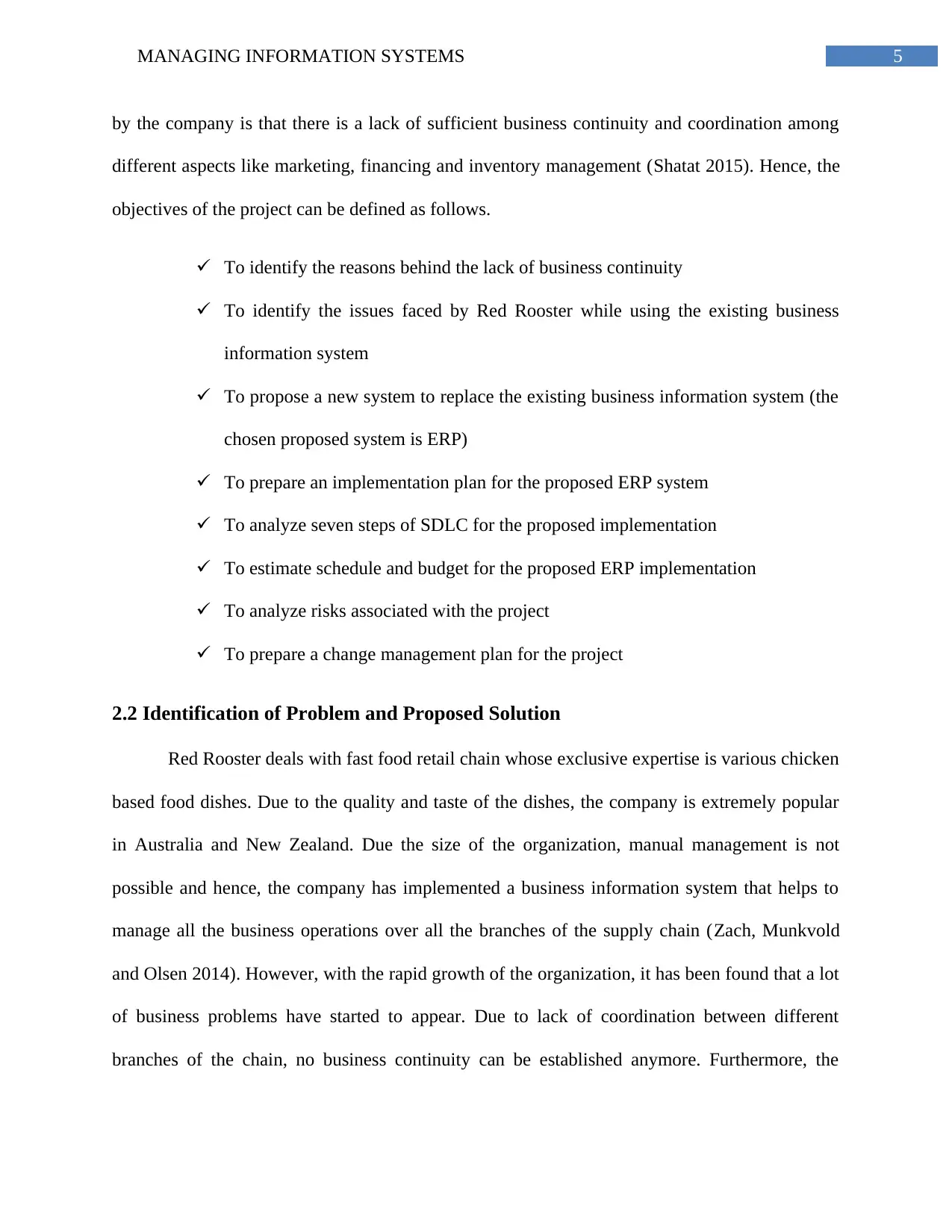
5MANAGING INFORMATION SYSTEMS
by the company is that there is a lack of sufficient business continuity and coordination among
different aspects like marketing, financing and inventory management (Shatat 2015). Hence, the
objectives of the project can be defined as follows.
To identify the reasons behind the lack of business continuity
To identify the issues faced by Red Rooster while using the existing business
information system
To propose a new system to replace the existing business information system (the
chosen proposed system is ERP)
To prepare an implementation plan for the proposed ERP system
To analyze seven steps of SDLC for the proposed implementation
To estimate schedule and budget for the proposed ERP implementation
To analyze risks associated with the project
To prepare a change management plan for the project
2.2 Identification of Problem and Proposed Solution
Red Rooster deals with fast food retail chain whose exclusive expertise is various chicken
based food dishes. Due to the quality and taste of the dishes, the company is extremely popular
in Australia and New Zealand. Due the size of the organization, manual management is not
possible and hence, the company has implemented a business information system that helps to
manage all the business operations over all the branches of the supply chain (Zach, Munkvold
and Olsen 2014). However, with the rapid growth of the organization, it has been found that a lot
of business problems have started to appear. Due to lack of coordination between different
branches of the chain, no business continuity can be established anymore. Furthermore, the
by the company is that there is a lack of sufficient business continuity and coordination among
different aspects like marketing, financing and inventory management (Shatat 2015). Hence, the
objectives of the project can be defined as follows.
To identify the reasons behind the lack of business continuity
To identify the issues faced by Red Rooster while using the existing business
information system
To propose a new system to replace the existing business information system (the
chosen proposed system is ERP)
To prepare an implementation plan for the proposed ERP system
To analyze seven steps of SDLC for the proposed implementation
To estimate schedule and budget for the proposed ERP implementation
To analyze risks associated with the project
To prepare a change management plan for the project
2.2 Identification of Problem and Proposed Solution
Red Rooster deals with fast food retail chain whose exclusive expertise is various chicken
based food dishes. Due to the quality and taste of the dishes, the company is extremely popular
in Australia and New Zealand. Due the size of the organization, manual management is not
possible and hence, the company has implemented a business information system that helps to
manage all the business operations over all the branches of the supply chain (Zach, Munkvold
and Olsen 2014). However, with the rapid growth of the organization, it has been found that a lot
of business problems have started to appear. Due to lack of coordination between different
branches of the chain, no business continuity can be established anymore. Furthermore, the
⊘ This is a preview!⊘
Do you want full access?
Subscribe today to unlock all pages.

Trusted by 1+ million students worldwide
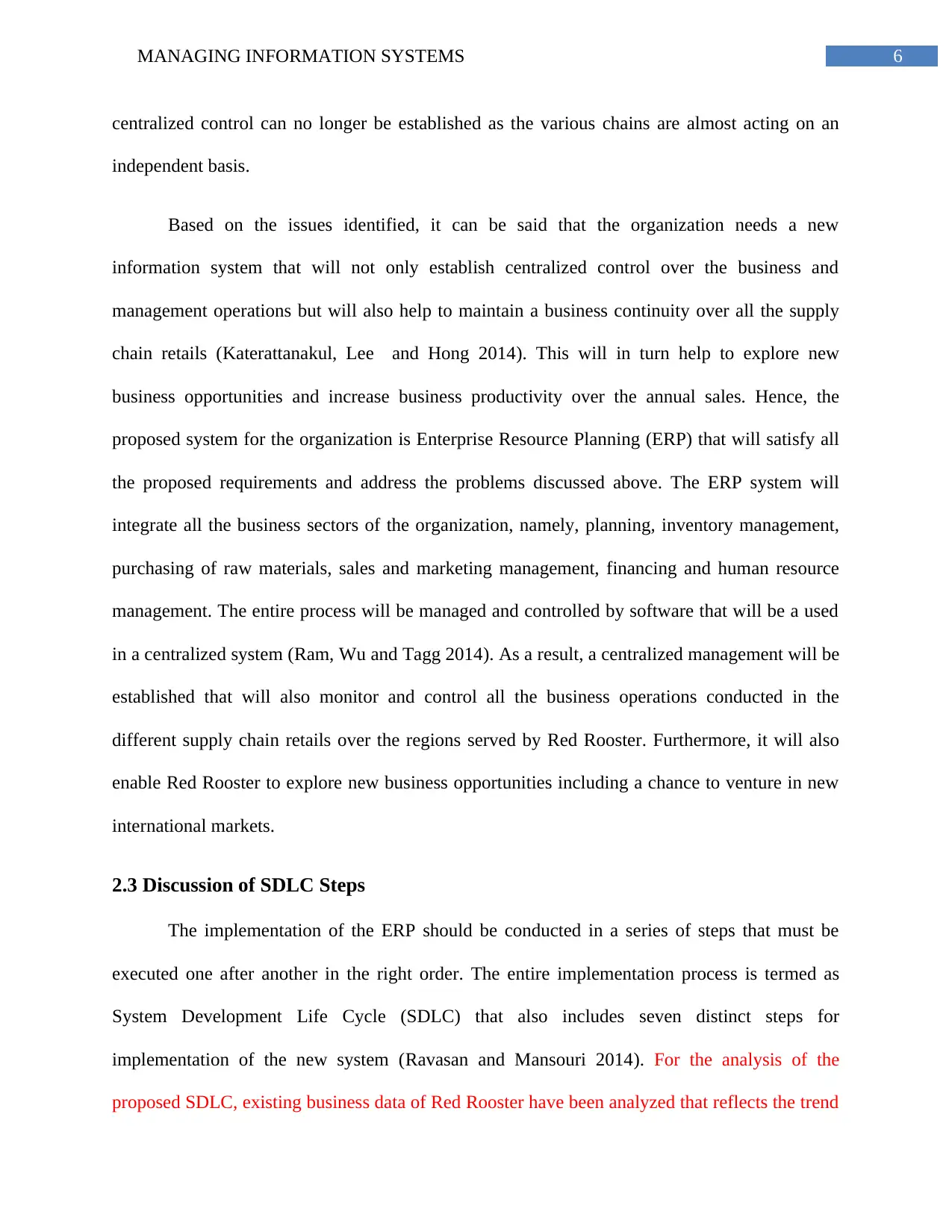
6MANAGING INFORMATION SYSTEMS
centralized control can no longer be established as the various chains are almost acting on an
independent basis.
Based on the issues identified, it can be said that the organization needs a new
information system that will not only establish centralized control over the business and
management operations but will also help to maintain a business continuity over all the supply
chain retails (Katerattanakul, Lee and Hong 2014). This will in turn help to explore new
business opportunities and increase business productivity over the annual sales. Hence, the
proposed system for the organization is Enterprise Resource Planning (ERP) that will satisfy all
the proposed requirements and address the problems discussed above. The ERP system will
integrate all the business sectors of the organization, namely, planning, inventory management,
purchasing of raw materials, sales and marketing management, financing and human resource
management. The entire process will be managed and controlled by software that will be a used
in a centralized system (Ram, Wu and Tagg 2014). As a result, a centralized management will be
established that will also monitor and control all the business operations conducted in the
different supply chain retails over the regions served by Red Rooster. Furthermore, it will also
enable Red Rooster to explore new business opportunities including a chance to venture in new
international markets.
2.3 Discussion of SDLC Steps
The implementation of the ERP should be conducted in a series of steps that must be
executed one after another in the right order. The entire implementation process is termed as
System Development Life Cycle (SDLC) that also includes seven distinct steps for
implementation of the new system (Ravasan and Mansouri 2014). For the analysis of the
proposed SDLC, existing business data of Red Rooster have been analyzed that reflects the trend
centralized control can no longer be established as the various chains are almost acting on an
independent basis.
Based on the issues identified, it can be said that the organization needs a new
information system that will not only establish centralized control over the business and
management operations but will also help to maintain a business continuity over all the supply
chain retails (Katerattanakul, Lee and Hong 2014). This will in turn help to explore new
business opportunities and increase business productivity over the annual sales. Hence, the
proposed system for the organization is Enterprise Resource Planning (ERP) that will satisfy all
the proposed requirements and address the problems discussed above. The ERP system will
integrate all the business sectors of the organization, namely, planning, inventory management,
purchasing of raw materials, sales and marketing management, financing and human resource
management. The entire process will be managed and controlled by software that will be a used
in a centralized system (Ram, Wu and Tagg 2014). As a result, a centralized management will be
established that will also monitor and control all the business operations conducted in the
different supply chain retails over the regions served by Red Rooster. Furthermore, it will also
enable Red Rooster to explore new business opportunities including a chance to venture in new
international markets.
2.3 Discussion of SDLC Steps
The implementation of the ERP should be conducted in a series of steps that must be
executed one after another in the right order. The entire implementation process is termed as
System Development Life Cycle (SDLC) that also includes seven distinct steps for
implementation of the new system (Ravasan and Mansouri 2014). For the analysis of the
proposed SDLC, existing business data of Red Rooster have been analyzed that reflects the trend
Paraphrase This Document
Need a fresh take? Get an instant paraphrase of this document with our AI Paraphraser
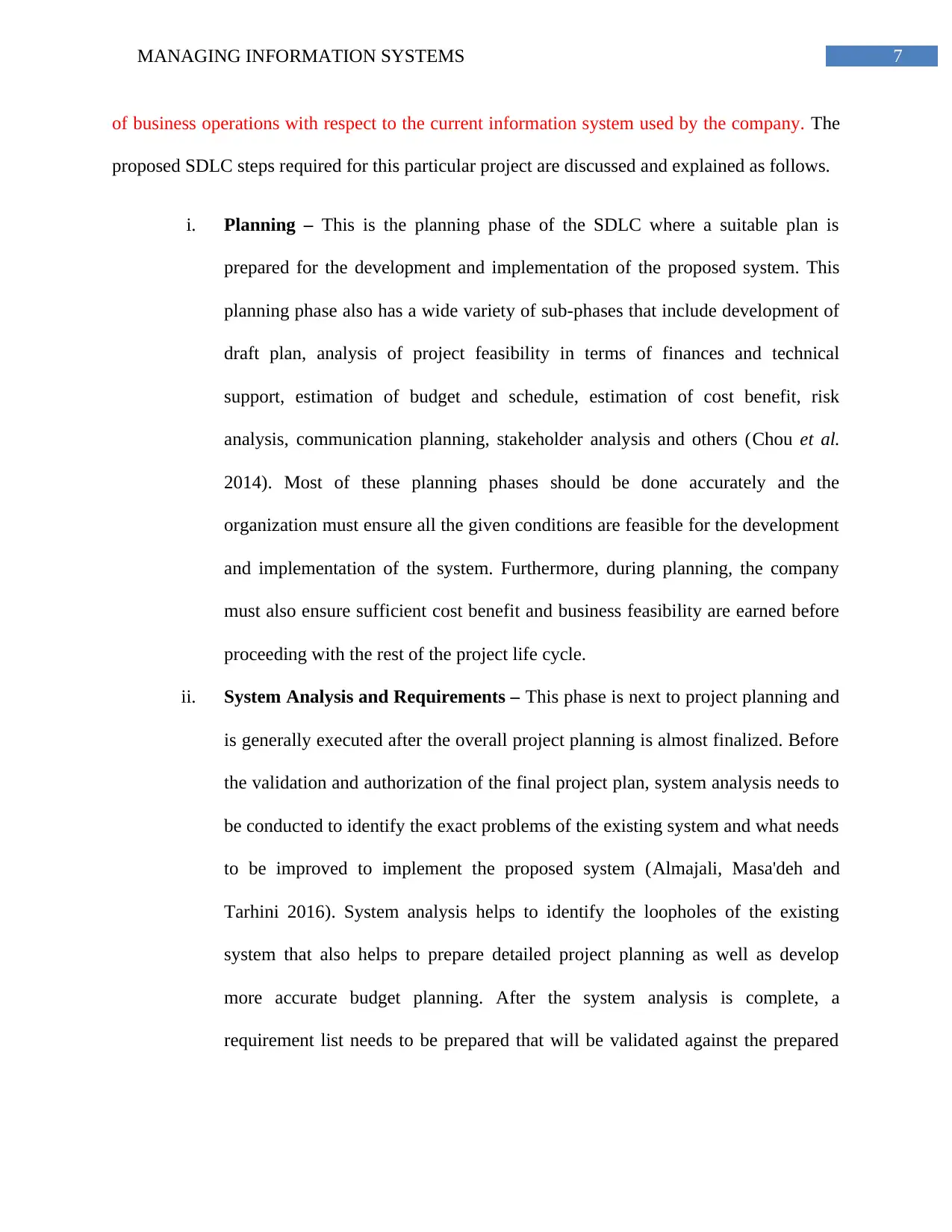
7MANAGING INFORMATION SYSTEMS
of business operations with respect to the current information system used by the company. The
proposed SDLC steps required for this particular project are discussed and explained as follows.
i. Planning – This is the planning phase of the SDLC where a suitable plan is
prepared for the development and implementation of the proposed system. This
planning phase also has a wide variety of sub-phases that include development of
draft plan, analysis of project feasibility in terms of finances and technical
support, estimation of budget and schedule, estimation of cost benefit, risk
analysis, communication planning, stakeholder analysis and others (Chou et al.
2014). Most of these planning phases should be done accurately and the
organization must ensure all the given conditions are feasible for the development
and implementation of the system. Furthermore, during planning, the company
must also ensure sufficient cost benefit and business feasibility are earned before
proceeding with the rest of the project life cycle.
ii. System Analysis and Requirements – This phase is next to project planning and
is generally executed after the overall project planning is almost finalized. Before
the validation and authorization of the final project plan, system analysis needs to
be conducted to identify the exact problems of the existing system and what needs
to be improved to implement the proposed system (Almajali, Masa'deh and
Tarhini 2016). System analysis helps to identify the loopholes of the existing
system that also helps to prepare detailed project planning as well as develop
more accurate budget planning. After the system analysis is complete, a
requirement list needs to be prepared that will be validated against the prepared
of business operations with respect to the current information system used by the company. The
proposed SDLC steps required for this particular project are discussed and explained as follows.
i. Planning – This is the planning phase of the SDLC where a suitable plan is
prepared for the development and implementation of the proposed system. This
planning phase also has a wide variety of sub-phases that include development of
draft plan, analysis of project feasibility in terms of finances and technical
support, estimation of budget and schedule, estimation of cost benefit, risk
analysis, communication planning, stakeholder analysis and others (Chou et al.
2014). Most of these planning phases should be done accurately and the
organization must ensure all the given conditions are feasible for the development
and implementation of the system. Furthermore, during planning, the company
must also ensure sufficient cost benefit and business feasibility are earned before
proceeding with the rest of the project life cycle.
ii. System Analysis and Requirements – This phase is next to project planning and
is generally executed after the overall project planning is almost finalized. Before
the validation and authorization of the final project plan, system analysis needs to
be conducted to identify the exact problems of the existing system and what needs
to be improved to implement the proposed system (Almajali, Masa'deh and
Tarhini 2016). System analysis helps to identify the loopholes of the existing
system that also helps to prepare detailed project planning as well as develop
more accurate budget planning. After the system analysis is complete, a
requirement list needs to be prepared that will be validated against the prepared
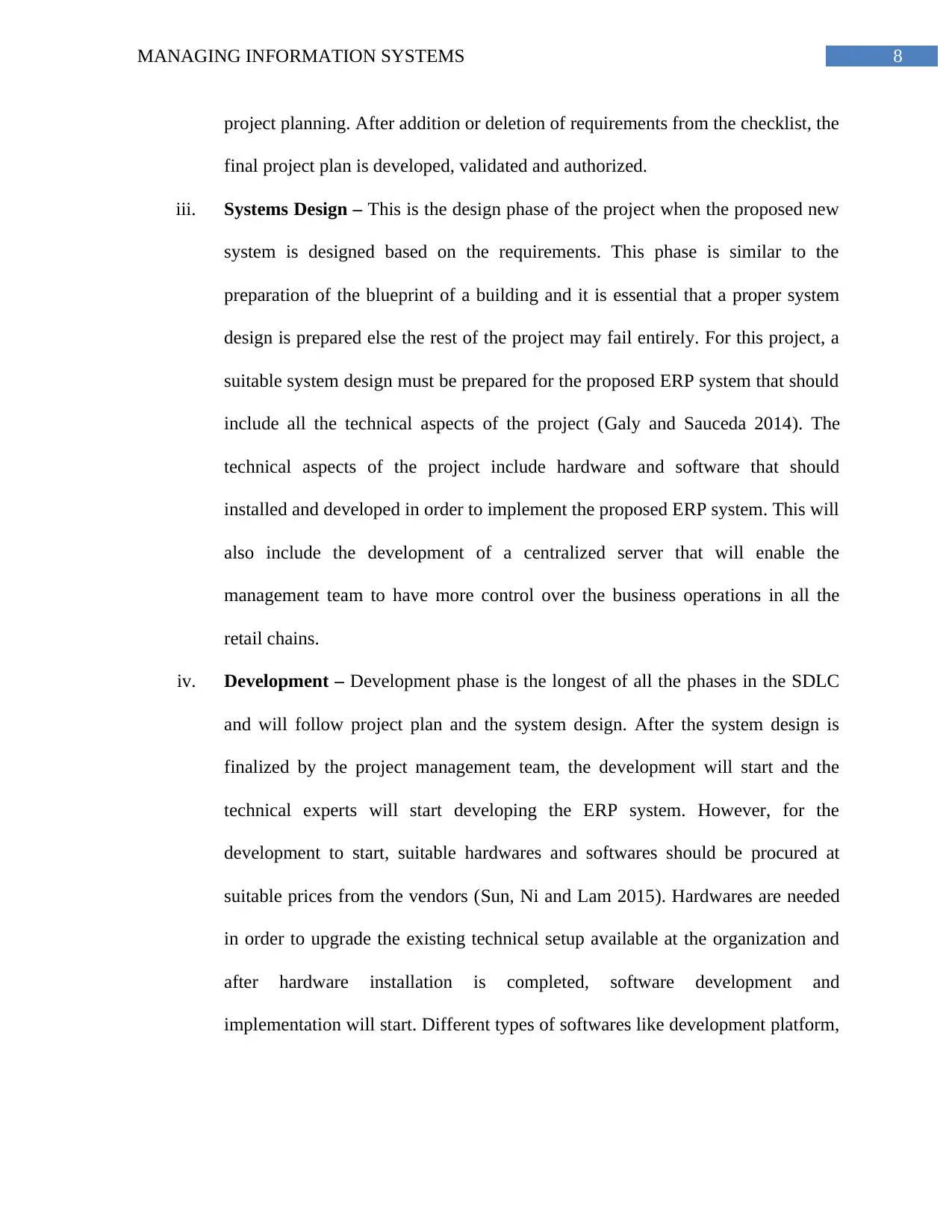
8MANAGING INFORMATION SYSTEMS
project planning. After addition or deletion of requirements from the checklist, the
final project plan is developed, validated and authorized.
iii. Systems Design – This is the design phase of the project when the proposed new
system is designed based on the requirements. This phase is similar to the
preparation of the blueprint of a building and it is essential that a proper system
design is prepared else the rest of the project may fail entirely. For this project, a
suitable system design must be prepared for the proposed ERP system that should
include all the technical aspects of the project (Galy and Sauceda 2014). The
technical aspects of the project include hardware and software that should
installed and developed in order to implement the proposed ERP system. This will
also include the development of a centralized server that will enable the
management team to have more control over the business operations in all the
retail chains.
iv. Development – Development phase is the longest of all the phases in the SDLC
and will follow project plan and the system design. After the system design is
finalized by the project management team, the development will start and the
technical experts will start developing the ERP system. However, for the
development to start, suitable hardwares and softwares should be procured at
suitable prices from the vendors (Sun, Ni and Lam 2015). Hardwares are needed
in order to upgrade the existing technical setup available at the organization and
after hardware installation is completed, software development and
implementation will start. Different types of softwares like development platform,
project planning. After addition or deletion of requirements from the checklist, the
final project plan is developed, validated and authorized.
iii. Systems Design – This is the design phase of the project when the proposed new
system is designed based on the requirements. This phase is similar to the
preparation of the blueprint of a building and it is essential that a proper system
design is prepared else the rest of the project may fail entirely. For this project, a
suitable system design must be prepared for the proposed ERP system that should
include all the technical aspects of the project (Galy and Sauceda 2014). The
technical aspects of the project include hardware and software that should
installed and developed in order to implement the proposed ERP system. This will
also include the development of a centralized server that will enable the
management team to have more control over the business operations in all the
retail chains.
iv. Development – Development phase is the longest of all the phases in the SDLC
and will follow project plan and the system design. After the system design is
finalized by the project management team, the development will start and the
technical experts will start developing the ERP system. However, for the
development to start, suitable hardwares and softwares should be procured at
suitable prices from the vendors (Sun, Ni and Lam 2015). Hardwares are needed
in order to upgrade the existing technical setup available at the organization and
after hardware installation is completed, software development and
implementation will start. Different types of softwares like development platform,
⊘ This is a preview!⊘
Do you want full access?
Subscribe today to unlock all pages.

Trusted by 1+ million students worldwide
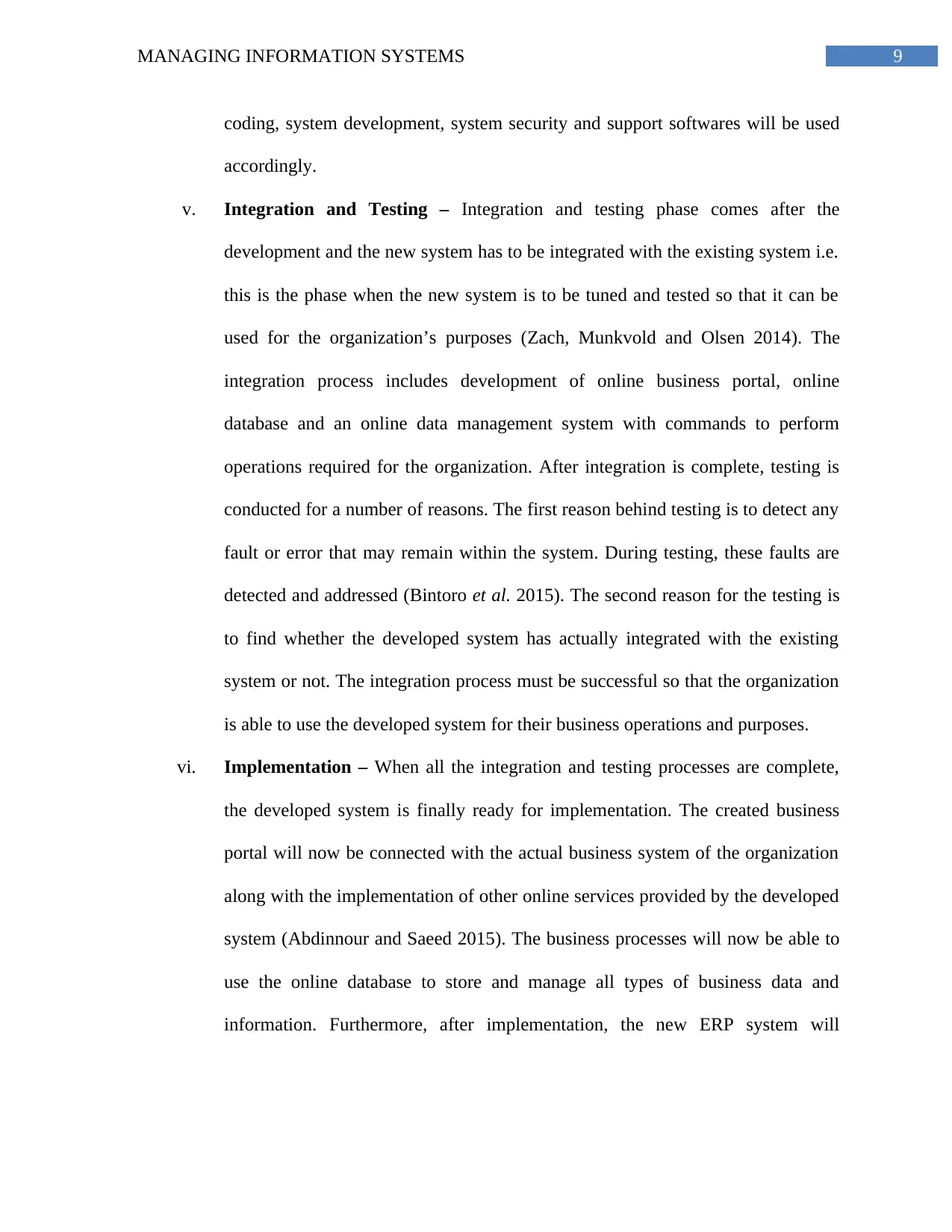
9MANAGING INFORMATION SYSTEMS
coding, system development, system security and support softwares will be used
accordingly.
v. Integration and Testing – Integration and testing phase comes after the
development and the new system has to be integrated with the existing system i.e.
this is the phase when the new system is to be tuned and tested so that it can be
used for the organization’s purposes (Zach, Munkvold and Olsen 2014). The
integration process includes development of online business portal, online
database and an online data management system with commands to perform
operations required for the organization. After integration is complete, testing is
conducted for a number of reasons. The first reason behind testing is to detect any
fault or error that may remain within the system. During testing, these faults are
detected and addressed (Bintoro et al. 2015). The second reason for the testing is
to find whether the developed system has actually integrated with the existing
system or not. The integration process must be successful so that the organization
is able to use the developed system for their business operations and purposes.
vi. Implementation – When all the integration and testing processes are complete,
the developed system is finally ready for implementation. The created business
portal will now be connected with the actual business system of the organization
along with the implementation of other online services provided by the developed
system (Abdinnour and Saeed 2015). The business processes will now be able to
use the online database to store and manage all types of business data and
information. Furthermore, after implementation, the new ERP system will
coding, system development, system security and support softwares will be used
accordingly.
v. Integration and Testing – Integration and testing phase comes after the
development and the new system has to be integrated with the existing system i.e.
this is the phase when the new system is to be tuned and tested so that it can be
used for the organization’s purposes (Zach, Munkvold and Olsen 2014). The
integration process includes development of online business portal, online
database and an online data management system with commands to perform
operations required for the organization. After integration is complete, testing is
conducted for a number of reasons. The first reason behind testing is to detect any
fault or error that may remain within the system. During testing, these faults are
detected and addressed (Bintoro et al. 2015). The second reason for the testing is
to find whether the developed system has actually integrated with the existing
system or not. The integration process must be successful so that the organization
is able to use the developed system for their business operations and purposes.
vi. Implementation – When all the integration and testing processes are complete,
the developed system is finally ready for implementation. The created business
portal will now be connected with the actual business system of the organization
along with the implementation of other online services provided by the developed
system (Abdinnour and Saeed 2015). The business processes will now be able to
use the online database to store and manage all types of business data and
information. Furthermore, after implementation, the new ERP system will
Paraphrase This Document
Need a fresh take? Get an instant paraphrase of this document with our AI Paraphraser
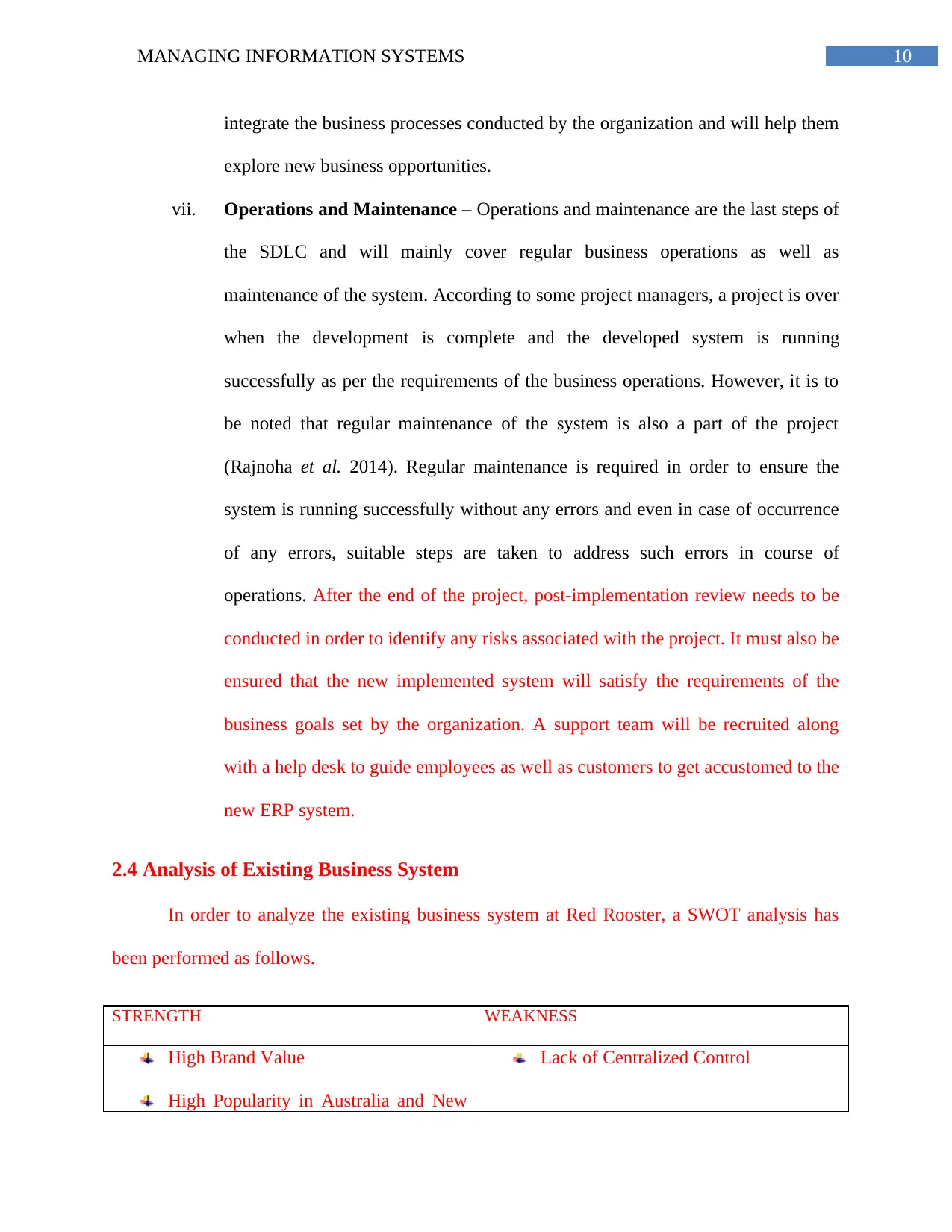
10MANAGING INFORMATION SYSTEMS
integrate the business processes conducted by the organization and will help them
explore new business opportunities.
vii. Operations and Maintenance – Operations and maintenance are the last steps of
the SDLC and will mainly cover regular business operations as well as
maintenance of the system. According to some project managers, a project is over
when the development is complete and the developed system is running
successfully as per the requirements of the business operations. However, it is to
be noted that regular maintenance of the system is also a part of the project
(Rajnoha et al. 2014). Regular maintenance is required in order to ensure the
system is running successfully without any errors and even in case of occurrence
of any errors, suitable steps are taken to address such errors in course of
operations. After the end of the project, post-implementation review needs to be
conducted in order to identify any risks associated with the project. It must also be
ensured that the new implemented system will satisfy the requirements of the
business goals set by the organization. A support team will be recruited along
with a help desk to guide employees as well as customers to get accustomed to the
new ERP system.
2.4 Analysis of Existing Business System
In order to analyze the existing business system at Red Rooster, a SWOT analysis has
been performed as follows.
STRENGTH WEAKNESS
High Brand Value
High Popularity in Australia and New
Lack of Centralized Control
integrate the business processes conducted by the organization and will help them
explore new business opportunities.
vii. Operations and Maintenance – Operations and maintenance are the last steps of
the SDLC and will mainly cover regular business operations as well as
maintenance of the system. According to some project managers, a project is over
when the development is complete and the developed system is running
successfully as per the requirements of the business operations. However, it is to
be noted that regular maintenance of the system is also a part of the project
(Rajnoha et al. 2014). Regular maintenance is required in order to ensure the
system is running successfully without any errors and even in case of occurrence
of any errors, suitable steps are taken to address such errors in course of
operations. After the end of the project, post-implementation review needs to be
conducted in order to identify any risks associated with the project. It must also be
ensured that the new implemented system will satisfy the requirements of the
business goals set by the organization. A support team will be recruited along
with a help desk to guide employees as well as customers to get accustomed to the
new ERP system.
2.4 Analysis of Existing Business System
In order to analyze the existing business system at Red Rooster, a SWOT analysis has
been performed as follows.
STRENGTH WEAKNESS
High Brand Value
High Popularity in Australia and New
Lack of Centralized Control
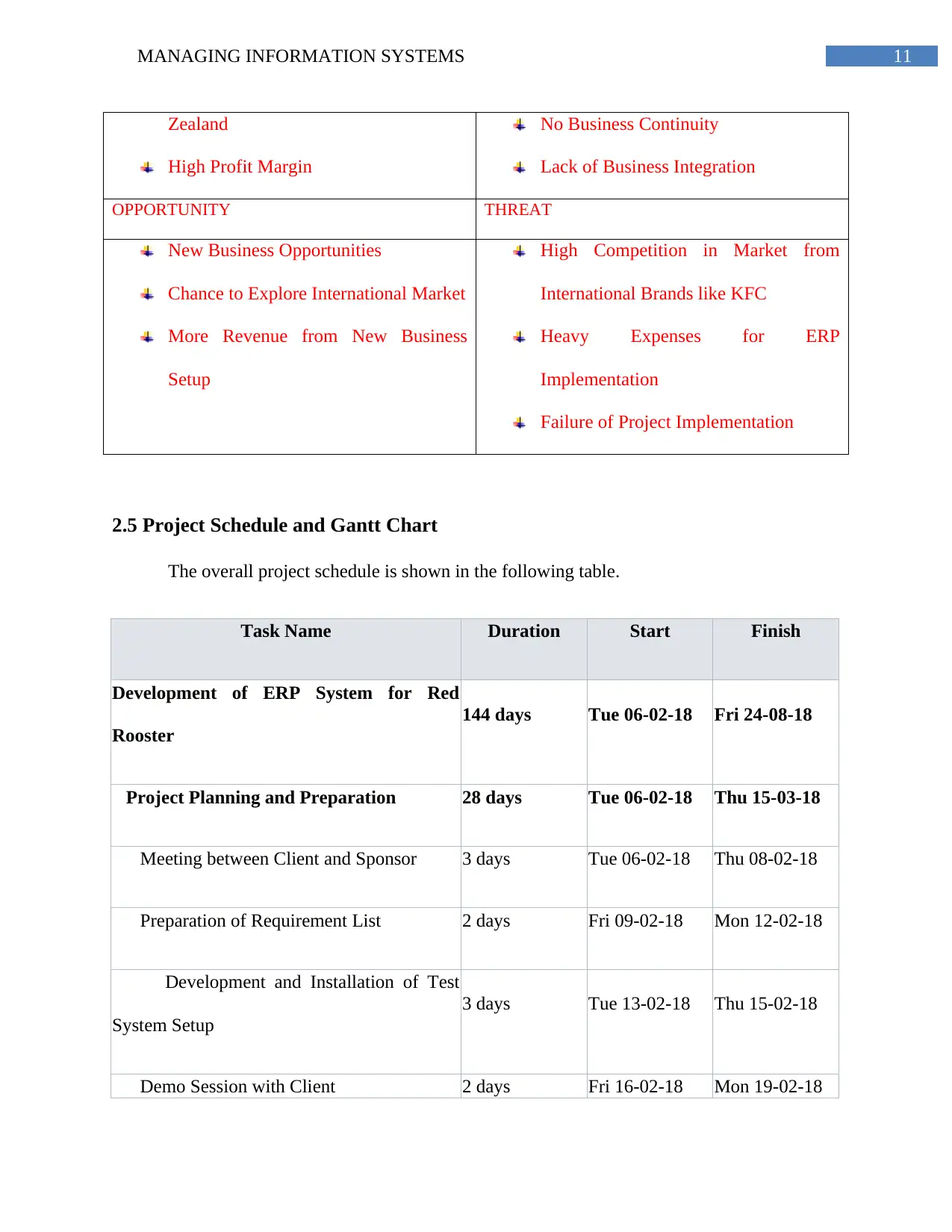
11MANAGING INFORMATION SYSTEMS
Zealand
High Profit Margin
No Business Continuity
Lack of Business Integration
OPPORTUNITY THREAT
New Business Opportunities
Chance to Explore International Market
More Revenue from New Business
Setup
High Competition in Market from
International Brands like KFC
Heavy Expenses for ERP
Implementation
Failure of Project Implementation
2.5 Project Schedule and Gantt Chart
The overall project schedule is shown in the following table.
Task Name Duration Start Finish
Development of ERP System for Red
Rooster
144 days Tue 06-02-18 Fri 24-08-18
Project Planning and Preparation 28 days Tue 06-02-18 Thu 15-03-18
Meeting between Client and Sponsor 3 days Tue 06-02-18 Thu 08-02-18
Preparation of Requirement List 2 days Fri 09-02-18 Mon 12-02-18
Development and Installation of Test
System Setup
3 days Tue 13-02-18 Thu 15-02-18
Demo Session with Client 2 days Fri 16-02-18 Mon 19-02-18
Zealand
High Profit Margin
No Business Continuity
Lack of Business Integration
OPPORTUNITY THREAT
New Business Opportunities
Chance to Explore International Market
More Revenue from New Business
Setup
High Competition in Market from
International Brands like KFC
Heavy Expenses for ERP
Implementation
Failure of Project Implementation
2.5 Project Schedule and Gantt Chart
The overall project schedule is shown in the following table.
Task Name Duration Start Finish
Development of ERP System for Red
Rooster
144 days Tue 06-02-18 Fri 24-08-18
Project Planning and Preparation 28 days Tue 06-02-18 Thu 15-03-18
Meeting between Client and Sponsor 3 days Tue 06-02-18 Thu 08-02-18
Preparation of Requirement List 2 days Fri 09-02-18 Mon 12-02-18
Development and Installation of Test
System Setup
3 days Tue 13-02-18 Thu 15-02-18
Demo Session with Client 2 days Fri 16-02-18 Mon 19-02-18
⊘ This is a preview!⊘
Do you want full access?
Subscribe today to unlock all pages.

Trusted by 1+ million students worldwide
1 out of 25
Related Documents
Your All-in-One AI-Powered Toolkit for Academic Success.
+13062052269
info@desklib.com
Available 24*7 on WhatsApp / Email
![[object Object]](/_next/static/media/star-bottom.7253800d.svg)
Unlock your academic potential
Copyright © 2020–2025 A2Z Services. All Rights Reserved. Developed and managed by ZUCOL.





